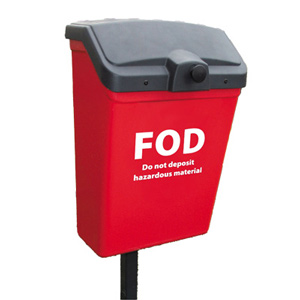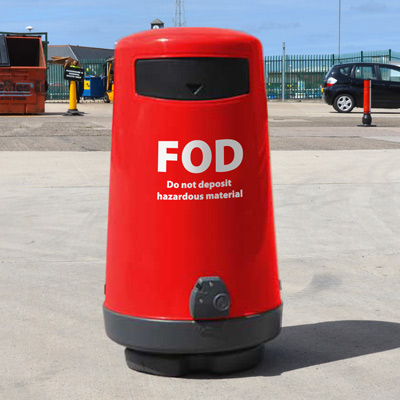Foreign object debris (FOD), has the potential to cause millions of dollars’ worth of damage in the aviation industry, as well as long delays and disruptions.
Estimates have found that there’s an annual bill of around $4 billion for the aerospace industry from the resulting damage caused by foreign object debris.*
By implementing appropriate, on-site airport FOD Containers, the potential financial implications, as well as the wider risks to airport personnel, can be significantly minimized.

What is FOD?
Broadly speaking, FOD can be classified as any object which could injure staff members, carrier personnel, or damage aircraft and equipment.
When focusing on a FOD aviation definition, some of the most common contributors are; rocks, sand, loose vegetation, tools and loose hardware, building materials, paper, paper clips, pens, coins, badges, baggage tags and pieces of luggage - including pieces of clothing/ footwear.
Even something as small, and seemingly insignificant, as undisposed litter has the potential to cause huge amounts of damage. A disregarded soda can or candy wrapper may not seem like a big deal to an 875,000 pound, $200 million Boeing 747-400, but such waste has the potential to cause a variety of problems:
How is FOD detected?
Whether you operate a small private airfield in your hometown, or run one of the world’s busiest international airports, dealing with foreign object debris is a concern which effects aviation as a whole – as well as many other fields, such as; the military, shipping, and manufacturing.
In order to detect FOD, advanced radar technology and human observation is normally the order of the day. Once FOD has been detected, it should be collected and logged by a member of staff, and stored in a dedicated FOD Container, usually located near the airport apron.
FOD solutions:
|
FOD Container 7G |
FOD Containers 23G |
||
 |
 |
||
|
Learn more |
Learn more |
Regardless of which method you use to detect and remove unwanted objects from your airside environment, having a dedicated FOD Container will allow you to dispose of your unwanted debris quickly, efficiently, and before it becomes a hazard which could cause harm or damage.
At Glasdon, we provide a range of designated FOD Containers, which are well suited to a variety of needs.
Whether you're looking for a solution to FOD prevention in manufacturing, reducing FOD in aviation maintenance, or anything else in-between, Glasdon FOD control products are here to help. Ranging from a compact 7 gallon FOD Container, right up to a larger 23 gallon FOD Container, our FOD cans are built to be durable, effective, and highly-visible.
And it's worth noting, if appropriate FOD control products aren't in place, the potential risks can be plentiful...
FOD airside effects:
There's a host of airside effects that can result from FOD, including; damaged aircraft engines if ingested, cut aircraft tyres and the obstruction of ground vehicles, propelled debris from jet engines can harm airport personnel/passengers, and debris can also become lodged in an aircraft's components, thus preventing it from operating safely.
FOD landside effects:
Landside effects of FOD can also be far-reaching; FOD can result in costly flight delays and cancellations - which could also lose future customers, there can also be schedule disruptions caused by the need to reposition airplanes and crews, as well as the potential liability due to injury and additional work for airport management and staff.
Adding branding and personalization to your FOD Containers:
Adding personalization to your FOD containers will also increase awareness amongst staff and members of the public within the vicinity of your site. Our personalization service is run by our dedicated in-house graphic design team, and we’ll provide you with a free-of-charge illustration of your personalized product. This way, you can see exactly how it will look, before placing an order.
For further guidance on how to approach this particular market, talk to us today, our industry professionals are always on hand to help.

Sources:
https://www.boeing.com/commercial/aeromagazine/aero_01/textonly/s01txt.html





